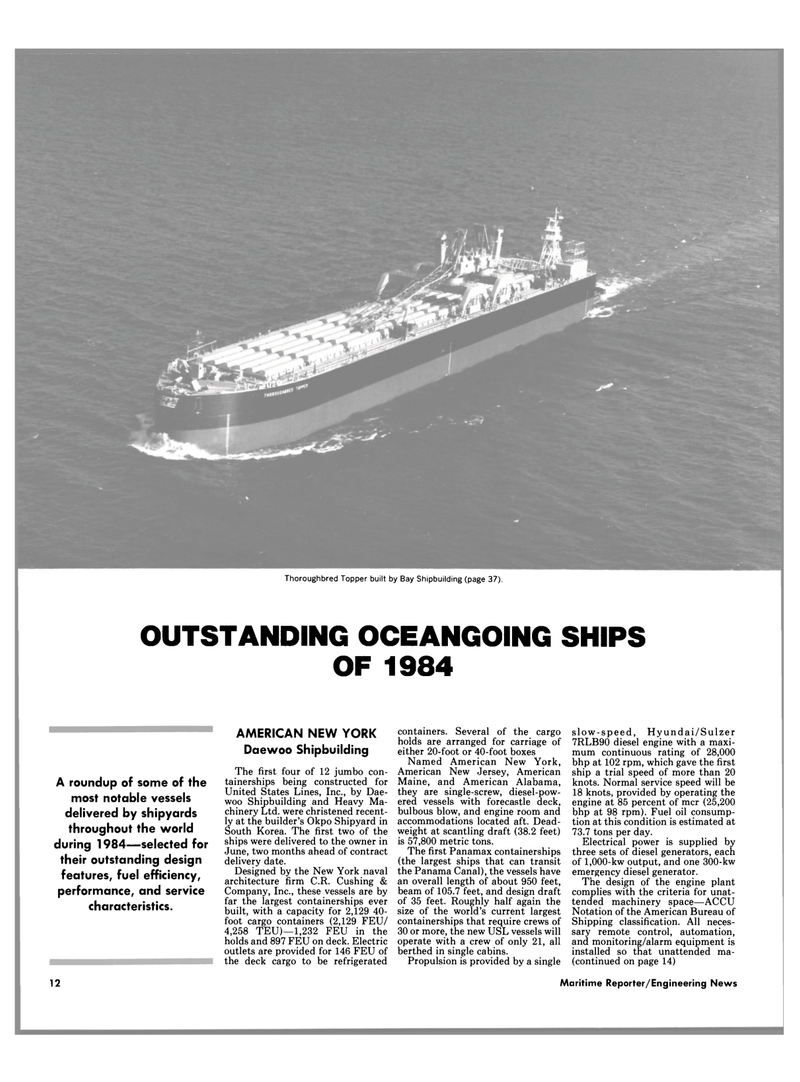
Page 10: of Maritime Reporter Magazine (December 1984)
Read this page in Pdf, Flash or Html5 edition of December 1984 Maritime Reporter Magazine
Thoroughbred Topper built by Bay Shipbuilding (page 37).
OUTSTANDING OCEANGOING SHIPS
OF 1984
A roundup of some of the most notable vessels delivered by shipyards throughout the world during 1984—selected for their outstanding design features, fuel efficiency, performance, and service characteristics.
AMERICAN NEW YORK
Daewoo Shipbuilding
The first four of 12 jumbo con- tainerships being constructed for
United States Lines, Inc., by Dae- woo Shipbuilding and Heavy Ma- chinery Ltd. were christened recent- ly at the builder's Okpo Shipyard in
South Korea. The first two of the ships were delivered to the owner in
June, two months ahead of contract delivery date.
Designed by the New York naval architecture firm C.R. Cushing &
Company, Inc., these vessels are by far the largest containerships ever built, with a capacity for 2,129 40- foot cargo containers (2,129 FEU/ 4,258 TEU)—1,232 FEU in the holds and 897 FEU on deck. Electric outlets are provided for 146 FEU of the deck cargo to be refrigerated containers. Several of the cargo holds are arranged for carriage of either 20-foot or 40-foot boxes
Named American New York,
American New Jersey, American
Maine, and American Alabama, they are single-screw, diesel-pow- ered vessels with forecastle deck, bulbous blow, and engine room and accommodations located aft. Dead- weight at scantling draft (38.2 feet) is 57,800 metric tons.
The first Panamax containerships (the largest ships that can transit the Panama Canal), the vessels have an overall length of about 950 feet, beam of 105.7 feet, and design draft of 35 feet. Roughly half again the size of the world's current largest containerships that require crews of 30 or more, the new USL vessels will operate with a crew of only 21, all berthed in single cabins.
Propulsion is provided by a single slow-speed, Hyundai/Sulzer 7RLB90 diesel engine with a maxi- mum continuous rating of 28,000 bhp at 102 rpm, which gave the first ship a trial speed of more than 20 knots. Normal service speed will be 18 knots, provided by operating the engine at 85 percent of mcr (25,200 bhp at 98 rpm). Fuel oil consump- tion at this condition is estimated at 73.7 tons per day.
Electrical power is supplied by three sets of diesel generators, each of 1,000-kw output, and one 300-kw emergency diesel generator.
The design of the engine plant complies with the criteria for unat- tended machinery space—ACCU
Notation of the American Bureau of
Shipping classification. All neces- sary remote control, automation, and monitoring/alarm equipment is installed so that unattended ma- (continued on page 14) 12 Maritime Reporter/Engineering News

 9
9

 11
11
